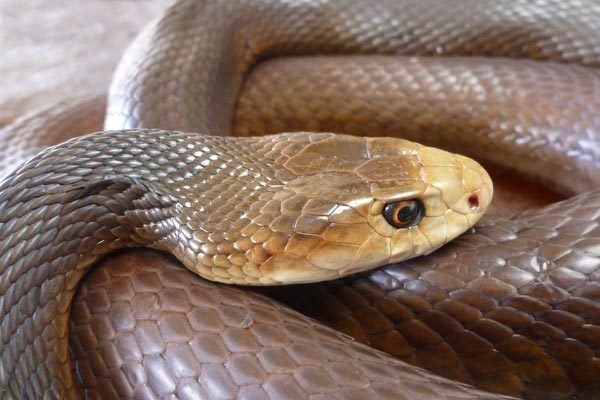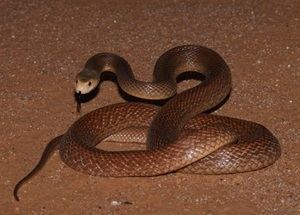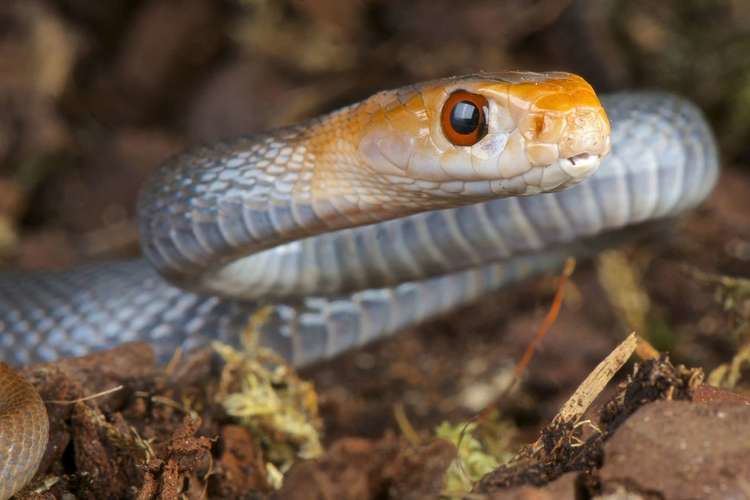Subphylum Vertebrata Suborder Serpentes Scientific name Oxyuranus scutellatus Rank Species | Phylum Chordata Higher classification Taipan | |
 | ||
Similar Snake, Taipan, Inland taipan, Pseudonaja, Eastern brown snake | ||
World s most dangerous snake coastal taipan oxyuranus s scutellatus venom extraction at krz
The coastal taipan (Oxyuranus scutellatus), or common taipan, is a species of large, highly venomous snake of the family Elapidae. It is native to the coastal regions of northern and eastern Australia and the island of New Guinea. According to most toxicological studies, this species is the sixth-most venomous land snake in the world based on its murine LD50.
Contents
- World s most dangerous snake coastal taipan oxyuranus s scutellatus venom extraction at krz
- The coastal taipan snake the third most deadly venomous snake in the world
- Physical description
- Scalation
- Distribution and habitat
- Habitat
- Behaviour and diet
- Diet
- Venom
- References

The coastal taipan snake the third most deadly venomous snake in the world
Physical description

Coastal taipans are large snakes. It is the largest venomous snake in Australia. Adult specimens of this species typically attains sexual maturity around 1.2 m (3.9 ft) in total length (body + tail). More mature specimens can grow to between 1.5 and 2.0 m (4.9 and 6.6 ft). Other taipans, including the inland taipan, attain broadly similar sizes although they tend to be slightly smaller in average size. A specimen of an average 2 m (6.6 ft) total length weighs around 3 kg (6.6 lb). According to the Queensland Museum, the longest recorded total length for the coastal taipan was a specimen that was 2.9 m (9.5 ft) and weighed 6.5 kg (14 lb). However, though exceptionally rare, much larger specimens are widely believed to exist, including specimens of as much as 3.3 m (11 ft). The taipan is exceeded in length among venomous snakes only by the Asiatic king cobra, African black mamba and genus Lachesis (bushmasters) of the American neotropics.

The head of this species is long and narrow like that of the African black mamba (but without the "coffin" shape). In fact, in several aspects of morphology, ecology and behaviour, the coastal taipan is strongly convergent with the black mamba (Dendroaspis polylepis). It has an angular brow and is lighter coloured on the face. The body is slender and colouration can vary. They are often uniformly light olive or reddish-brown in colour, but some specimens may be dark gray to black. The colouration is lighter on the sides of the body, and the ventral side (the belly) is usually a creamy-white to a pale light yellow in colour, and is often marked with orange or pink flecks. Individuals undergo a seasonal change in colour, becoming darker in winter and fading in summer. The eyes are large, round,and are light brown or even hazel in colour with large pupils.
Scalation

Dorsal scales at mid-body number 21–23, ventrals 220–250, subcaudals 45–80; the subcaudals are divided, and the anal plate is single, temporals 2+3 (3+4).
Distribution and habitat

Coastal taipans occur only in Australia and the island of New Guinea, which comprises two Indonesian provinces on the west side of the island and the nation of Papua New Guinea on the east side of the island.

Found in northern and eastern Australia, the coastal taipan snake, despite its name, can live in habitats hundreds of kilometres away from the nearest beach. Their range extends from north-western Western Australia, the Northern Territory, across Cape York Peninsula and down eastern Queensland into northern New South Wales (as far south as Grafton). However, the coastal taipan is not found in regions where the maximum winter temperature is below 20 °C (68 °F). The second subspecies (Oxyuranus scutellatus canni) is found throughout the island of New Guinea, with higher concentrations of the snake being found in the nation of Papua New Guinea.
Habitat
Coastal taipans can be found in a variety of different habitats. They can be found in warm, wetter temperate to tropical coastal regions, in monsoon forests, wet and dry sclerophyll forests and woodlands, and in natural and artificial grassy areas, including grazing paddocks, and disused rubbish tips. In Queensland, they have adapted well to sugarcane fields, where they thrive on the rodent population in the fields. In Far North Queensland in the Cape York Peninsula, they are usually found in open woodland areas. Thickets of introduced lantana are also favoured habitat. The coastal taipan shelters in abandoned animal burrows, hollow logs and in piles of vegetation and litter.
Behaviour and diet
The coastal taipan is primarily diurnal, being mostly active in the early to mid-morning period, although it may become nocturnal in hot weather conditions. When hunting, it appears to actively scan for prey using its well-developed eyesight, and is often seen traveling with its head raised slightly above ground level. Once prey is detected, the snake ‘freezes’ before hurling itself forward and issuing several quick bites. The prey is released and allowed to stagger away. This strategy minimizes the snake’s chance of being harmed in retaliation, particularly by rats, which can inflict lethal damage with their long incisors and claws. It is not a confrontational snake and will seek to escape any threat. When cornered, though, it can become very aggressive and may strike repeatedly.
Diet
The coastal taipan feeds solely on warm-blooded animals such as mammals and birds and their diet consists entirely of rats, mice, bandicoots and various species of birds.
Venom
This snake is the world's sixth-most venomous snake. The SC LD50 value of this species is 0.106 mg/kg, according to Australian Venom and Toxin database, and 0.12 mg/kg, according to Engelmann and Obst (1981). The average venom yield per bite is 120 mg, with a maximum record of 400 mg.
Its venom contains primarily taicatoxin, a highly potent neurotoxin affecting the nervous system and the blood’s ability to clot. Bite victims may experience headache, nausea/vomiting, collapse, convulsions, paralysis, internal bleeding, myolysis (destruction of muscle tissue), and kidney damage. In case of severe envenomation, death can occur as early as 30 minutes after being bitten, but the average is around 2.5 hours. The time between a bite and death depends on various factors such as the nature of the bite and the constitution of the victim. Untreated bites have a mortality rate of 100% as the coastal taipan always delivers a fatal dose of venom (an average bite delivers 1000x the lethal dose of venom for a human adult male), and medical professionals recommend that victims seek immediate medical attention even for apparently minor bites. Before the introduction of specific antivenom by the Commonwealth Serum Laboratories in 1956, nearly all bites were fatal.
